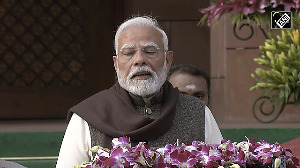The Vidarbha region in Maharashtra was the first to get a Rs 3,750-crore (Rs 37.50 billion) relief package from Prime Minister Manmohan Singh, but it was Karnataka that witnessed the maximum cases of suicide by farmers since 2000.
As per the figures of farmers' suicide compiled by the Union agriculture ministry on the basis of reports sent by different states, Maharashtra stands third.
From 2000-01 to 2005-06, around 8,600 farmers committed suicide in Karnataka, while the figures stood over 2,000 in Andhra Pradesh for the same period. In case of Maharashtra, the government reported 981 farmer suicides between 2001 and 2005.
So, what was it that drew the attention of the prime minister to Vidarbha first? A sharp spurt in suicide cases was reported from Vidarbha in the past six months. Unofficial figures put the estimated number of cases at around 600 in Vidarbha. But it was much worse in Andhra Pradesh as per official figures -- 1,068 farmers committing suicide in barely six months, from May 14, 2005 to November 11, 2005.
A day before the prime minister's visit to Vidarbha, J M Pathank, the Maharashtra government's official spokesman, had said at a press conference that the percentage of suicides recorded in Kerala, Karnataka, Tamil Nadu, Rajasthan and Goa was higher than in Maharashtra.
Although Pathank might have been unwittingly questioning the wisdom of the central government for scheduling the prime minister's visit to Vidarbha, he was not incorrect.
As per the figures compiled by Rajasthan police department, over 2,400 farmers committed suicide in the state between 2000 and 2003. The government of India's figures on farmers' suicide, however, does not include Rajasthan.
These discrepancies raise several questions about the authenticity of the figures on farmers' suicide in different parts of the country, even as the Centre prepares a rehabilitation package for 31 districts in Maharashtra, Karnataka, Andhra Pradesh and Kerala, which are said to be the most affected.
The then Opposition Congress in Andhra Pradesh had made farmers' suicide their central plank in the 2004 Assembly election to unseat the Telugu Desam Party. In July 2004, the prime minister visited Hyderabad and Kurnool districts to review the state government's efforts to check suicides.
The prime minister had left Hyderabad with the promise that he would personally go into farm-related issues. About two years hence, he was visiting Vidarbha while the crisis continued to worsen in Andhra Pradesh.
Kodand Ram, a Hyderabad-based social activist working with farmers' organisations, finds the government's approach to farmers' suicide 'discriminatory.' "Actually, most of the suicide cases are in Telangana region, which does not have much political clout in the government of the day (in AP)," he said.
Dr Revati from the Centre for Economic & Social Studies, Hyderabad, said that it was difficult to explain the increase in suicide cases in Andhra Pradesh last year.
"Suicide due to crop failures and mounting debts has been a continuous process. Only that it has started getting reported more now," she said.
If there is no plausible explanation for the sharp spurt in such cases in Andhra Pradesh, no explanation is forthcoming from either official or independent agencies on the continuous and sharp decline in farmers' suicides in Karnataka, going by official figures -- from 2,630 in 2000-01 they came down to 706 in 2003-04, 271 in 2004-05 and 124 in 2005-06.
Advocate Anup Srivastava from Human Rights Law Network, which has been working with other organisations on this issue, questioned the very credibility of the official figures.
"Official figures are coming down in Karnataka because the government wants to show it coming down. Cases of farmers' suicide are not registered. Otherwise, there is no change in farmers' plight. Our experience shows that suicides by farmers have only increased," he said.







 © 2025
© 2025